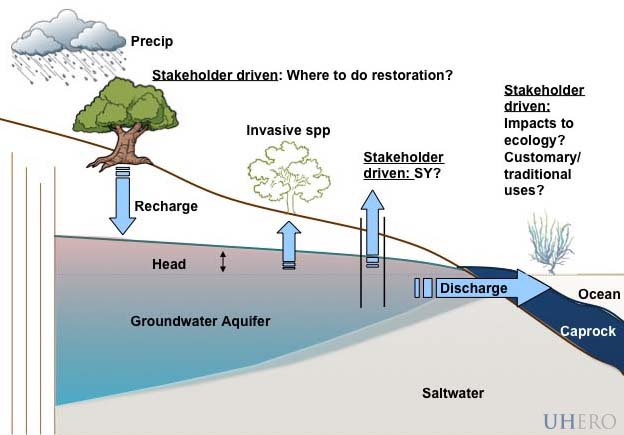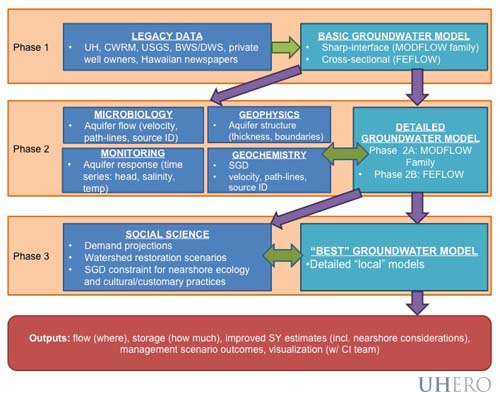‘Ike Wai (from the Hawaiian ‘ike, meaning knowledge, and wai, meaning water) is a five-year National Science Foundation project. The multidisciplinary research team from UH Manoa and Hilo will collect new geophysical and groundwater data, integrate these data into detailed groundwater models, and generate an improved understanding of subsurface water location, volume and flow paths. Data and outputs from ‘Ike Wai will be used to develop decision making tools to address challenges to fresh water scarcity from climate variability, increasing population demands, and water contamination.

UHERO Project Environment researchers will work with stakeholders to develop land-use scenarios, with a particular emphasis on potential areas for watershed restoration. Recharge values and restoration costs will be estimated for these scenarios and used as inputs to the groundwater model. Assumptions about development and population growth will be used to project consumption on the demand side, and the groundwater model will then allocate pumping spatially to minimize declines in water levels and deterioration in water quality due to seawater intrusion (SWI). Results from the pumping simulations can then be compared with current estimates of sustainable yield. We will also estimate the return on investment in watershed restoration for each of the scenarios.


The new field data and groundwater modeling efforts will help to improve current sustainable yield estimates. With recharge likely to change in the future due to climate change and land use decisions (e.g. watershed restoration), sustainable yield should also be variable. Although, current estimates of sustainable yield do not account for ecological and customary uses, several stakeholders have shown interest in developing a framework to do so. We will therefore look at how submarine groundwater discharge (SGD) along the coast varies with pumping and simulate the effects of different SGD constraints. We will also estimate the costs, in terms of restricting groundwater pumping, of enforcing those constraints. That is, we will: (1) compare projected groundwater consumption under each scenario to new sustainable yield estimates that account for both SWI and SGD, and (2) estimate the potential costs of maintaining pumping below sustainable yield.
BLOG POSTS ARE PRELIMINARY MATERIALS CIRCULATED TO STIMULATE DISCUSSION AND CRITICAL COMMENT. THE VIEWS EXPRESSED ARE THOSE OF THE INDIVIDUAL AUTHORS. WHILE BLOG POSTS BENEFIT FROM ACTIVE UHERO DISCUSSION, THEY HAVE NOT UNDERGONE FORMAL ACADEMIC PEER REVIEW.



